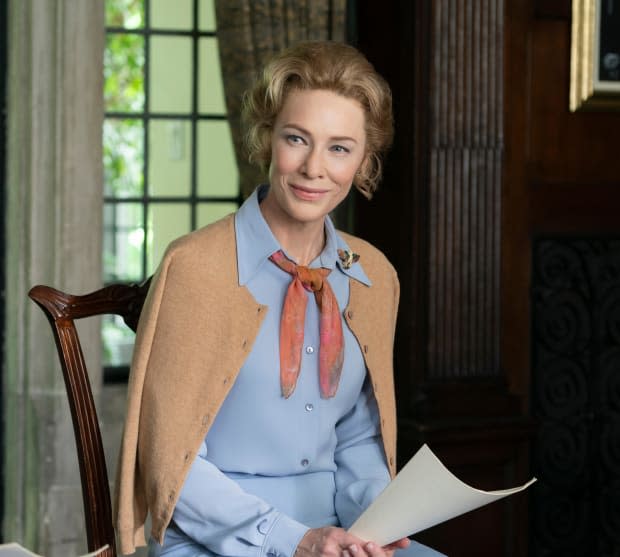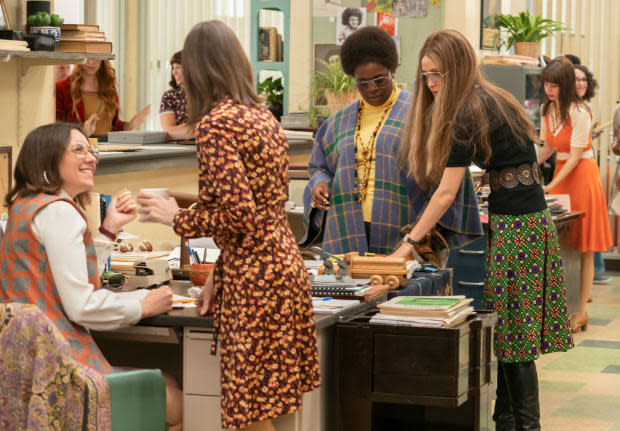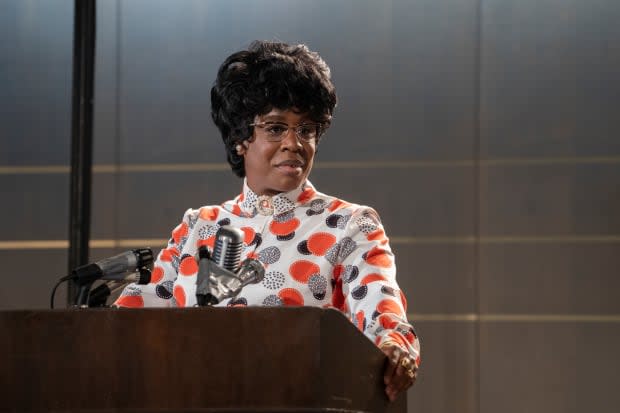The Costumes in 'Mrs. America' Mirror the Political Fight of the 1970s Women's Rights Movement
Cate Blanchett, Rose Byrne and Uzo Aduba share how Bina Daigeler's costumes helped transform them into their characters.
More often than not, "Mrs. America" — which portrays the historical figures and socio-political groundswells behind the movement to ratify the Equal Rights Amendment in the 1970s — feels very 2020. The new series, which airs on FX on Hulu, tells the story of the feminists leading the charge, as well as that of the the group against it, led by ultra-conservative "activist housewife" Phyllis Schlafly, played by the formidable Cate Blanchett.
The two-time Oscar winner and executive producer brought Bina Daigeler on board to design the period-authentic costumes spanning a definitive decade of the E.R.A. crusade, which dates back to the mid-1800s. (The amendment needed ratification by three-fourths of the 50 states, which only happened symbolically when Virginia became the 38th state to pass it in January 2020.)
"It's very easy, with period, to feel like you've been dropped into a time where people are wearing costumes and [Daigeler] has very much designed clothes that are all character-based," said Blanchett on a press conference call, prior to the series premiere. "I had some of the best creative conversations with Bina."

Daigeler's costume range runs from Pedro Almodóvar classics to the Dolly Parton-soundtracked teen pageant movie "Dumplin'" to Disney's delayed live-action "Mulan." For "Mrs. America," she told Fashionista she created "a very, very strict and big line" with color palettes to illustrate — and juxtapose — the values and messaging behind the opposing sides. Her costumes depict a line-up of trailblazers, including Ms. Magazine co-founder Gloria Steinem (Rose Byrne) and Shirley Chisholm (Uzo Aduba), the first African-American Congresswoman and first woman and African American to seek a presidential nomination from a major U.S. political party.
The "pros" — or the diverse, bi-partisan group of women pushing for equality across gender, race and sexuality, plus reproductive health rights — protested and lobbied in neutral, earthy and '70s fashion-forward hues, as well as a plethora of denim. The homogenous "antis," easily roused by Phyllis's misinformation and fear-mongering campaigns, wore a rainbow of pastels in silhouettes harking back a decade or two earlier.
Related Articles:
In 'Little Fires Everywhere,' Reese Witherspoon and Kerry Washington Wear Your Favorite '90s Brands
Zoë Kravitz's Costumes in 'High Fidelity' Reference Kurt Cobain, 'Reality Bites'-Era Winona Ryder and '90s Drew Barrymore
All the Fashion References in 'Katy Keene,' From the Dior New Look to Anna Wintour to Alexa Chung
"They looked a little bit like macarons," said Daigeler, over the phone from her home in Madrid, of the latter. "Nobody was wearing pants. Because the '50s and '60s are still what we understand of as the 'American housewife.' A really clean, proper, crisp [look] with aprons, pastel colors and the little hand-knit sweaters and the blouses. We wanted them to look a little bit like they're on a pedestal and — because they are not 'libbers' — they can't get out. They are closed in their tiny world."
To depict the late Schlafly — whose last book, published in 2016, is titled "The Conservative Case for Trump" — Daigeler used her real-life signature palette of red, white and blue, as well as variations on the hues: sky, camel, cream and poppy. The costume designer custom-built all of Phyllis's nipped-waist, peplum skirt suits in wooly, tweed or brocade textures; delicate cable-knit cardigan sets; below-the-knee skirts and conservative delicate block heels.

Daigeler also recreated some of Schlafly's well-documented real-life outfits: a pink and white polka-dot shirt under a white vest dress for a Kansas City, Missouri Republican committee meeting and an ivory mac-style wool coat for an E.R.A. protest outside of the White House. She meticulously duplicated a persimmon pointelle sweater and maxi-skirt set (above) for a couples debate between Phyllis and her lawyer husband Fred (John Slattery, being the most John Slattery) against Mark Feigen Fasteau (Adam Brody, with excellent '70s hair) and his wife Brenda (Ari Graynor), co-director alongside Ruth Bader-Ginsberg of the A.C.L.U. Women's Rights Project. (The Harvard Law School classmates combined both their surnames, and in alphabetical.)
"I just thought, 'I can't get it better color-wise,'" said Daigeler of the pristine knit set, which, though a similar hue, couldn't have contrasted more with Brenda's vintage, free-flowing, striped peasant dress. "One is the perfect intellectual New York couple and the other is somehow the perfect conservative Middle America couple."
In a particularly anti-E.R.A. celebration in 1979, Phyllis cuts an imposing figure as she holds court in a sculptural, pleated gown — white on top, with red and blue skirting, of course. Fittingly, the show promo poster (below) features Blanchett in the severe and almost futuristic piece, which Schlafly actually wore, but to a different dinner in 1982.
Daigeler and Blanchett came across the dress during their research (at the 1:00 mark here) and were taken by how much the fashion-forward gown veered from the virulent anti-communist's usual conservative aesthetic. "Well, we were obsessed," said Blanchett.

To stay accurate to the 1979 gala portrayed in the finale, Daigeler began recreating the mint-green plissé gown Phyllis actually wore to the event. But late one night, she fell into a vintage shopping spiral on Etsy. "I saw Phyllis Schlaffly's dress! I just thought, 'It's not true. You're fantasizing. It's 3:00 a.m.,'" she said with a laugh. She ordered it, just in case. It arrived, "the smallest, super crumpled little package," without label, so the provenance is still a mystery. She rushed it to Blanchett's trailer, and remembered the actor saying: "'Bina, this is creepy.' She tried it on and we were like, 'OK, we need that. It has to be in the show.'"
The costumes for the "pros" include an "In the Mood for Love"-inspired thrifted '50s dress for "The Feminist Mystique" author and National Organization of Women (N.O.W.) co-founder, Betty Friedan (Tracey Ullman) — per director Amma Asante's vision — as well as signature hats for U.S. House Representative and co-founder of the National Women's Political Caucus, Bella Azbug (Margo Martindale) and chic printed sets and power pantsuits for Republican head of the White House Office of Women's Programs, Jill Ruckelhaus (Elizabeth Banks).
When she first appears, sauntering into a glam Ms. Magazine bash at the Guggenheim, feminist (and fashion) icon Steinem looks like she's walking out of a Vogue spread, in a psychedelic-print mini-dress and cropped, shaggy fur coat. (Her long middle-parted hair is neatly tucked into the sides of her famous aviators, of course.)

"[Steinem] was such an iconic figure in her look. She created this thing. She was impeccable with her style always, which was really fun, really, really fun to create," said Byrne, also on a press conference call. "And Bina, her background is so diverse and interesting. She has such a great eye. The things she remade — like a pair of jeans for me or a T-shirt — it was very specific from the cut, to the texture, to the fabrics."
Daigeler tracked Steinem's real-life sartorial evolution from "a more feminine and sexy direction," with mini-skirts and knee-high boots in the late '60s and early '70s, to a confidently relaxed but alluring, "very, very easy" jeans and tees. She custom-built most of the wardrobe, including all those perfect high-waisted flares.
She did, however, sprinkle in a few choice designer vintage pieces, like a red and white, chainlink-print wrap dress by Diane von Furstenberg (Steinem's real-life friend), a chevron-knit dress by Missoni and a green and purple tile-print mini by Yves Saint Laurent styled with a short-sleeve button-up sweater and a circular-studded statement belt (above). The latter look further accentuates top editor and "money guy" Clay Felker's sexist and diminishing comment to Gloria about her legs, as he overrides her decision to put Chisholm on the 1972 Democratic National Convention cover in front of her all-female staff.
The third episode, "Shirley," depicts Chisholm's history-making bid for a presidential nomination, plus it explores the progression of intersectionality within the feminist movement. Aduba's moving and powerful portrayal of the culmination of Chisholm's campaign, and her eventual withdrawal from the race, gave me chills — and viscerally felt like a gut-punch — following the 2020 Democratic primaries, which began with the most diverse field in history.

To recreate the historically-documented pieces Chisholm wore to the 1972 convention, Daigeler replicated the original graphics and colors with printed fabrics: a blue and white, geometric-patterned jacket (actually worn in January that year, to announce her primary bid); an orange and brown circle-motif shirt, accented with a dainty pearl brooch, to address her enthusiastic delegates (above); and the red, white and blue floral dress, as she, the only woman and only person of color, stands on-stage between Senators Hubert Humphrey and eventual nominee George McGovern. "[I treated Chisholm's costumes as if we] were doing a documentary because I owed that to the portrayal," said Daigeler.
While Aduba found inspiration wearing these recreations of Chisholm's famous ensembles, she found the costume support that the viewers couldn't see just as meaningful — if not more. "It helps you to understand the amount of armor women had to [wear to] walk out the door to start the day," the actor said, on a press conference call. Daigeler stayed authentic to the layers of foundation garments that were holdovers from the '50s and '60s: a bra, a girdle and panty hose — all of which the double Emmy- and triple SAG Award-winner committed to, even in the scorching summer days during shooting.
"It's just the weight of everything you have to carry as a woman," Aduba continued. "That helps you to understand, 'Oh, this liberation isn't just from an economic and professional place.' There were physical liberations that were happening as well. Very powerful."
The first three episodes of 'Mrs. America' drop Wednesday, April 15 on Hulu, with one streaming each Wednesday for the following six weeks.
Never miss the latest fashion industry news. Sign up for the Fashionista daily newsletter.

